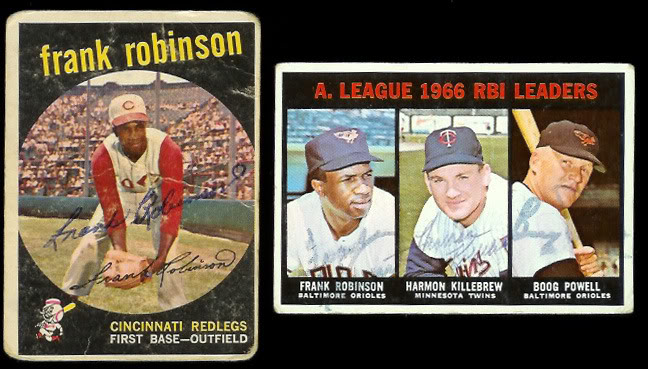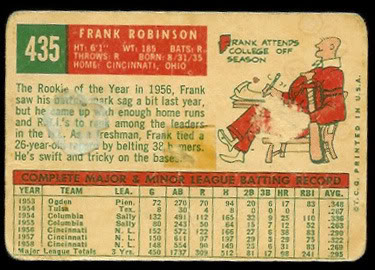Frank Robinson has had one of the most brilliant and successful careers in the history of big league baseball.
He has been a manager, player, executive and whatever else he was asked to do by the Office of the Commissioner in recent years. He was a Hall of Fame player.
He started by winning the NL Rookie of the Year award in 1956, hitting 38 home runs at the age of 20. He spent his first ten years with the Cincinnati Reds, hitting 30 home runs or more seven times and .300 five times. Vada Pinson often hit ahead of him, and Pete Rose was the lead-off hitter starting in 1963. Robinson's most notable year was 1962, when he hit 39 home runs, with 136 RBI and a .342 batting average.
In 1966, the Cincinnati Reds decided that Robinson was "an old 30" and traded him to the Baltimore Orioles in exchange for Milt Pappas. He responded by won the Triple Crown, the accomplishment for which he is best remembered.
He also was the AL MVP and the World Series MVP. He spent six years with the Orioles, hitting over .300 four times and continuing to hit home runs, leading to Orioles to finish in first place four times.
On Mother's Day 1966, Robinson became the only player who ever would hit a ball out of Baltimore's Memorial Stadium -- thereafter a flag was flown where the ball had cleared the outer wall. It read "HERE".
After an injury-plagued year with the Los Angeles Dodgers, when he hit 19 home runs in less than 2/3 of a season, he came to the California Angels where he hit 30 home runs in 1973 at the age of 37. He finished his playing career with the Cleveland Indians.
Robinson went on to manage 17 years in the majors (the first two years as a player/manager for Cleveland). He became the first African-American manager in major league history when he took over at the helm of the Tribe in 1975.
He was a member of the Orioles coaching staff from 1978 to 1980. He managed the San Francisco Giants for parts of four seasons before returning to the O's as a coach from 1985 to 1987 and manager from 1988 to 1991.
Frank Robinson served as MLB's "Vice-President of On-Field Operations" before coming out of retirement from coaching to manage the then Montreal Expos in 2002, and managed the Expos/Washington Nationals until the end of the 2006 season.
As a player, had his head not had a fateful collision with Al Weis' knee in the 1968 season, he may have put up even greater numbers.
This 1959 Topps baseball card is signed in a beautiful ballpoint pen. It is card number 435 in the 1959 Topps set. It is worn and has a spot of tape, a spot of glue, and a spot of paper loss on the back.
The 1967 American League R.B.I. Leaders from 1966, card number 241 in the 1967 Topps set (and signed by Frank Robinson, Boog Powell and Harmon Killebrew) is being sold in a separate auction).

